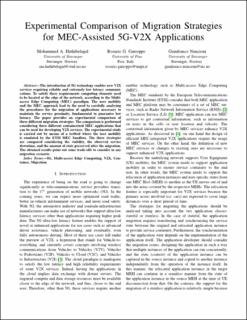| dc.contributor.author | Hathibelagal, Mohammed Ashraff | |
| dc.contributor.author | Garroppo, Rosario G. | |
| dc.contributor.author | Nencioni, Gianfranco | |
| dc.date.accessioned | 2023-02-09T11:20:25Z | |
| dc.date.available | 2023-02-09T11:20:25Z | |
| dc.date.created | 2022-10-21T20:50:17Z | |
| dc.date.issued | 2022 | |
| dc.identifier.citation | Hathibelagal, M. A., Garroppo, R. G., & Nencioni, G. (2023). Experimental comparison of migration strategies for MEC-assisted 5G-V2X applications. Computer Communications, 197, 1-11. | en_US |
| dc.identifier.issn | 0140-3664 | |
| dc.identifier.uri | https://hdl.handle.net/11250/3049622 | |
| dc.description.abstract | The introduction of 5G technology enables new V2X services requiring reliable and extremely low latency communications. To satisfy these requirements computing elements need to be located at the edge of the network, according to the Multi-access Edge Computing (MEC) paradigm. The user mobility and the MEC approach lead to the need to carefully analysing the procedures for the migration of applications necessary to maintain the service proximity, fundamental to guarantee low latency. The paper provides an experimental comparison of three different migration strategies. The comparison is performed considering three different containerized MEC applications that can be used for developing V2X services. The experimental study is carried out by means of a testbed where the user mobility is emulated by the ETSI MEC Sandbox. The three strategies are compared considering the viability, the observed service downtime, and the amount of state preserved after the migration. The obtained results point out some trade-offs to consider in any migration scenario. | en_US |
| dc.language.iso | eng | en_US |
| dc.publisher | Elsevier | en_US |
| dc.title | Experimental comparison of migration strategies for MEC-assisted 5G-V2X applications | en_US |
| dc.title.alternative | Experimental comparison of migration strategies for MEC-assisted 5G-V2X applications | en_US |
| dc.type | Peer reviewed | en_US |
| dc.type | Journal article | en_US |
| dc.description.version | acceptedVersion | en_US |
| dc.rights.holder | The authors | en_US |
| dc.subject.nsi | VDP::Teknologi: 500 | en_US |
| dc.source.journal | Computer Communications | en_US |
| dc.identifier.doi | 10.1016/j.comcom.2022.10.009 | |
| dc.identifier.cristin | 2063885 | |
| dc.relation.project | Norges forskningsråd: 308909 | en_US |
| cristin.ispublished | true | |
| cristin.fulltext | postprint | |
| cristin.qualitycode | 1 | |
